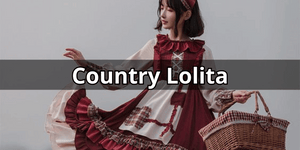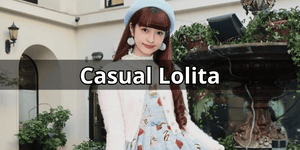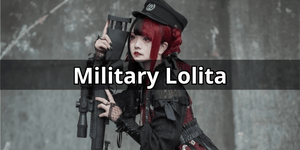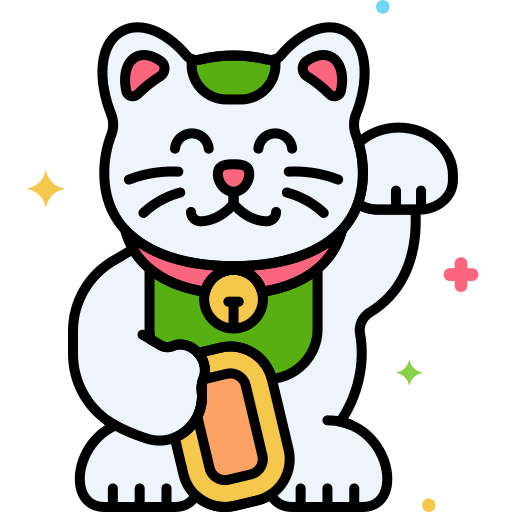Navigating the world of fashion means exploring a myriad of styles, each with its own story, its own essence. At the heart of this mosaic, Japan's Classic Lolita fashion emerges like a breath of fresh air, combining timeless elegance with contemporary nuances. Born of the intersection between the refinement of the Victorian and Rococo eras and Japanese creativity, this fashion is much more than just a trend. It's a statement, a tribute to a glamorous past, delicately transposed into the present. So let's plunge together into the bewitching world of Classic Lolita.
History and introduction to Classic Lolita

At the heart of Japan's diverse fashion landscape, the Classic Lolita style stands out as an echo of yesteryear's elegance. Although the Lolita movement took root in the 1980s, in response to Tokyo's growing kawaii culture, it was in the early 2000s that the Classic Lolita sub-genre really began to define itself. Inspired by various eras, this style is a fusion of European history and Japanese modernity, recalling a time when sophistication and refinement were revered.
The classic Lolita aesthetic, defined by its silhouettes, subtle patterns and soft colors, lies halfway between the past and the present. It's less a direct replica of historical fashions than a reinterpretation, adapted to contemporary trends and sensibilities. While lace, corsets and hats evoke bygone eras, their incorporation into the modern world, particularly in the dynamic urban context of Japan, testifies to the style's ability to remain relevant and attractive through the ages.
Historical and Cultural Influences
Classic Lolita fashion, while deeply rooted in the present, is a reflective mirror of earlier eras when delicacy and refinement were at the heart of every creation. The most obvious influence is the Rococo and Victorian period, marked by structured silhouettes, delicate lace and meticulous attention to detail. These eras, with their corseted dresses, voluminous petticoats and elaborate hairstyles, provided a solid foundation on which Classic Lolita fashion was built, integrating these elements while adapting them to modern taste.
At the same time, the unique fusion of this Western inspiration with Japanese sensibility gave birth to something entirely new. Japanese culture, with its values of harmony, balance and precision, played an essential role in moderating the extravagance of these historic eras. So, although the motifs and silhouettes are clearly reminiscent of the past, there is a subtlety, a restraint, that is undeniably Japanese. It is this cultural encounter, this alliance between Western history and Japanese aesthetic philosophy, that gives Classic Lolita aesthetic its depth and uniqueness, making it more than just a fashion, but a cross-cultural celebration.
Differences From Other Lolita Sub-Genres

Lolita fashion, with its many facets and nuances, offers a diversity of styles which, while sharing common elements, each have their own distinctive characteristics. Classic Lolita, in its quest for timeless elegance, subtly differentiates itself from its counterparts. To better understand its uniqueness, let's compare it to other popular sub-genres of Lolita fashion:
- Sweet Lolita: Where Classic Lolita revels in subtle patterns and a soft color palette, the Sweet Lolita fashion fully embraces the world of pastels, ribbons and childlike motifs. Sweet Lolita outfits are often adorned with sweets, animals and fairy-tale elements, with an emphasis on candor and innocence.
- Gothic Lolita: While Classic Lolita draws its inspiration from the Victorian and Rococo eras, Gothic Lolita takes on a darker aesthetic. Dark shades such as black, purple and burgundy dominate, with Gothic and sometimes occult-influenced motifs.
- Punk Lolita: While retaining the basic silhouettes of Lolita fashion, Punk Lolita introduces iconic punk elements such as studs, chains and tartans. It's a bold mix of rebellion and refinement.
- Country Lolita: Inspired by the countryside and rural life, this sub-genre combines elements of Classic Lolita with country motifs, such as fruit, flowers and gingham.
Color Harmony, an Important Point
The Classic Lolita color palette is a harmonious blend of soft, sophisticated hues, evoking a sense of timeless elegance and refinement. Unlike the bright palettes of Sweet Lolita or the dark hues of Gothic Lolita, Classic Lolita opts for colors that exude subtlety. From creamy beiges to delicate browns, powder blues to sage greens, each color is chosen for its ability to convey a nostalgic yet soothing mood. Prints, often floral or nature-inspired, use this palette to create patterns that are both easy on the eyes and expressive.
Deeper shades, such as burgundy, navy and gray, also find their way into Classic Lolita, often serving as a base or contrast to lighter patterns. These darker hues add gravitas and depth, anchoring the style in a maturity that sets it apart from other sub-genres. Yet even with this diversity, there's a consistency to the color palette. Whether it's a delicate pastel dress or a darker-hued accessory, each element harmonizes to celebrate the understated charm and elegance of Classic Lolita.
Essential Classic Lolita Clothing

Behind every Classic Lolita outfit, a multitude of elements intertwine to create visual and aesthetic harmony. Each piece, from the main garment to the most subtle accessories, is carefully chosen to reflect the essence of this Japanese fashion. Here are just a few of the fundamental Classic Lolita clothes:
- Dresses: Often featuring A-line silhouettes or bell shapes, these dresses can be One Pieces or Jumperskirts. They are characterized by discreet patterns, refined lace and clean cuts.
- Blouses: Usually with long or three-quarter sleeves, these are designed to complement dresses. Peter Pan collars and ornate cuffs are particularly popular in this style.
- Shoes: Mary Janes, oxfords and small heels are the preferred choices, in keeping with the soft hues of the Classic Lolita color palette.
- Lolita Hairstyles: In contrast to the exuberant bonnets of Sweet Lolita, Classic Lolita prefers more sober hats, discreet barrettes and headbands adorned with lace or pearls.
- Accessories: Elegant handbags, delicate jewelry and vintage brooches complete the outfit, adding a finishing touch without overpowering the look.
How to Create Classic Lolita Outfits ?

The art of creating a Classic Lolita outfit lies in the ability to subtly balance historical and modern elements while respecting the nuances of this aesthetic. It all starts with the centerpiece, usually a lolita dress or skirt. It should reflect the key attributes of the style: discreet patterns, soft colors and careful details such as lace or ornate buttons. For true immersion in style, it's essential to choose a piece that evokes timeless elegance. Once this foundation is established, it's a matter of adding layers to complete the look.
A blouse with puffed sleeves or a shirt with a Claudine collar can add a touch of Victorian authenticity. Shoes, whether Mary Janes or low-heeled pumps, should blend harmoniously into the ensemble. Accessories also play a crucial role. Tights or knee-high socks, delicate jewelry and perhaps a brooch or elegant handbag can transform a simple outfit into a true Classic Lolita outfit. The trick is to always favor quality over quantity, selecting each element for its ability to blend perfectly into the ensemble, creating a perfect, soft visual harmony.
Clothes Brands to Know For This Japanese Fashion
The success and popularity of the Classic Lolita style is not only the result of collective admiration, but is also supported and nurtured by iconic brands who have dedicated their expertise to designing exceptional pieces for this fashion. Through their commitment to the Classic Lolita aesthetic, these brands have helped shape and define the style over the years. Here are just a few of the must-have brands:
- Innocent World: Renowned for designs that fuse classic and modern elements, this brand perfectly embodies the spirit of Classic Lolita with its delicate patterns and elegant silhouettes.
- Victorian Maiden: As its name suggests, Victorian Maiden draws deeply on Victorian inspiration, offering refined pieces with meticulous attention to detail.
- Mary Magdalene: Specializing in outfits that look straight out of a period painting, this brand is famous for its tailored cuts, quality fabrics and embroidered motifs.
- Juliette et Justine: With a more artistic touch, this brand stands out for its pictorial designs that often tell a story, while remaining true to the Classic Lolita aesthetic.
Conclusion
In our journey through the maze of Classic Lolita fashion, we discovered much more than a simple style of dress: it's a whole universe imbued with nostalgia, delicacy and authenticity. Combining the elegance of bygone eras with the modernity of today's Japan, this fashion perfectly illustrates how tradition and contemporary trends can coexist harmoniously. Beyond the fabrics and patterns, Classic Lolita is a reminder that, in the fast-paced world of fashion, certain essences remain eternal, crossing time without ever losing their lustre.












